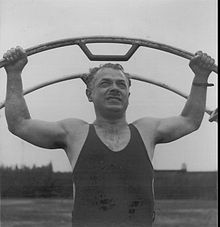Otto Feick
Otto Feick (born July 4, 1890 in Reichenbach , Palatinate ; † October 17, 1959 in Schönau an der Brend ) was the inventor of the gym wheel .
Life
Feick was born in 1890 as the son of a blacksmith . He was a locksmith and railroad worker . From 1914 to 1923 he worked in the Deutsche Reichsbahn plant in Ludwigshafen am Rhein . At that time he lived in Ludwigshafen-Gartenstadt . He was a supporter of the trade union movement and a member of the main board of the union of railway workers in Germany .
Even as a child he liked to roll down the mountain in two iron tires connected by cross bars. Feick invented the prototype of the gym wheel in Ludwigshafen am Rhein. A photo, taken in the swimming pool of the VSK Niederfeld, served as a template for the patent, which he applied for from Schönau an der Brend. Feick came to his wife's hometown, Schönau an der Brend, after being expelled from the Palatinate by the French occupiers. Together with other acquaintances, he founded a metal workshop in Schönau and manufactured toys and bed frames, among other things. He built in 1924/25 a further variation of his invention Rhönrad in the Niederschedener drawing and stamping Schedetal (temporarily Rhönrad works Niederscheden today Kunststoffwerk AVI), this work had received from Feick the license to manufacture Rhon wheels. The statement that he made his invention in Scheden and was an employee of the plant is not proven. He had the idea for this in 1921 during his imprisonment in Mainz, where he was imprisoned by the French military police and given a suspended sentence because of his activities in the defensive fight against the attempts to break away from the Palatinate. In various letters Feick documented that when he was a boy in his grandfather's forge in Reichenbach (Palatinate) he took two iron tires and connected them to one another and rolled them down a slope.
On the site of today's VSK-Germania Niederfeld 1919 e. V., whose founder and first chairman he was in 1919, he made the first attempts. This is also where the pictures for the patent application were created .
Later, on the run from the French occupiers, he moved to Schönau an der Brend, the hometown of his wife Pauline, née Schmalz, whom he had met during his active service in the military - with the "hunters" in Aschaffenburg . To thank his new home in the Bavarian Rhön , he named the new piece of sports equipment the gym wheel. In August 1930 he organized the first international wheel tournament in the nearby spa town of Bad Kissingen .
In 1927 he moved to Würzburg , and then back to Schönau an der Brend, where he died on October 17, 1959 in poor conditions.
Otto Feick's motto in life was: Fight, wrestle - but sing!
In Schönau, from where the triumphant advance of the gym wheel began, a monument was erected to him and the gym wheel. In Glan-Münchweiler , where Otto Feick lived for a few years, there is a monument in the form of a gymnastics wheel in the roundabout of Bundesstraße 423 in the Bettenhausen district.
The composer and publisher Leopold Maaß (1872–1957), who fled from National Socialism and finally came to America via Shanghai , wrote a small, three-stanza vocal work for voice and piano for the inventor of the gymnastics wheel around 1928, the so-called "Rhönrad- Song". It is headed with the words: "Dedicated to the inventor of the gym wheel, Mr. Otto Feick, Würzburg [sic!] With admiration". This opus was performed and recorded again for the first time in 88 years on the occasion of the 54th German Gymnastics Championships, held by the DJK Olympia Schönau on the occasion of the 90th Gymnastics Anniversary in Bad Neustadt .
literature
- Anette Konrad: First attempts at taxiing on the Blies. How Otto Feick from Ludwigshafen invented the gym wheel 90 years ago. In: The Rheinpfalz / Ludwigshafener Rundschau No. 198 from August 18, 2012. ZDB -ID 209783-7
Web links
| personal data | |
|---|---|
| SURNAME | Feick, Otto |
| BRIEF DESCRIPTION | Inventor of the gym wheel |
| DATE OF BIRTH | 4th July 1890 |
| PLACE OF BIRTH | Reichenbach |
| DATE OF DEATH | 17th October 1959 |
| Place of death | Schönau an der Brend |

